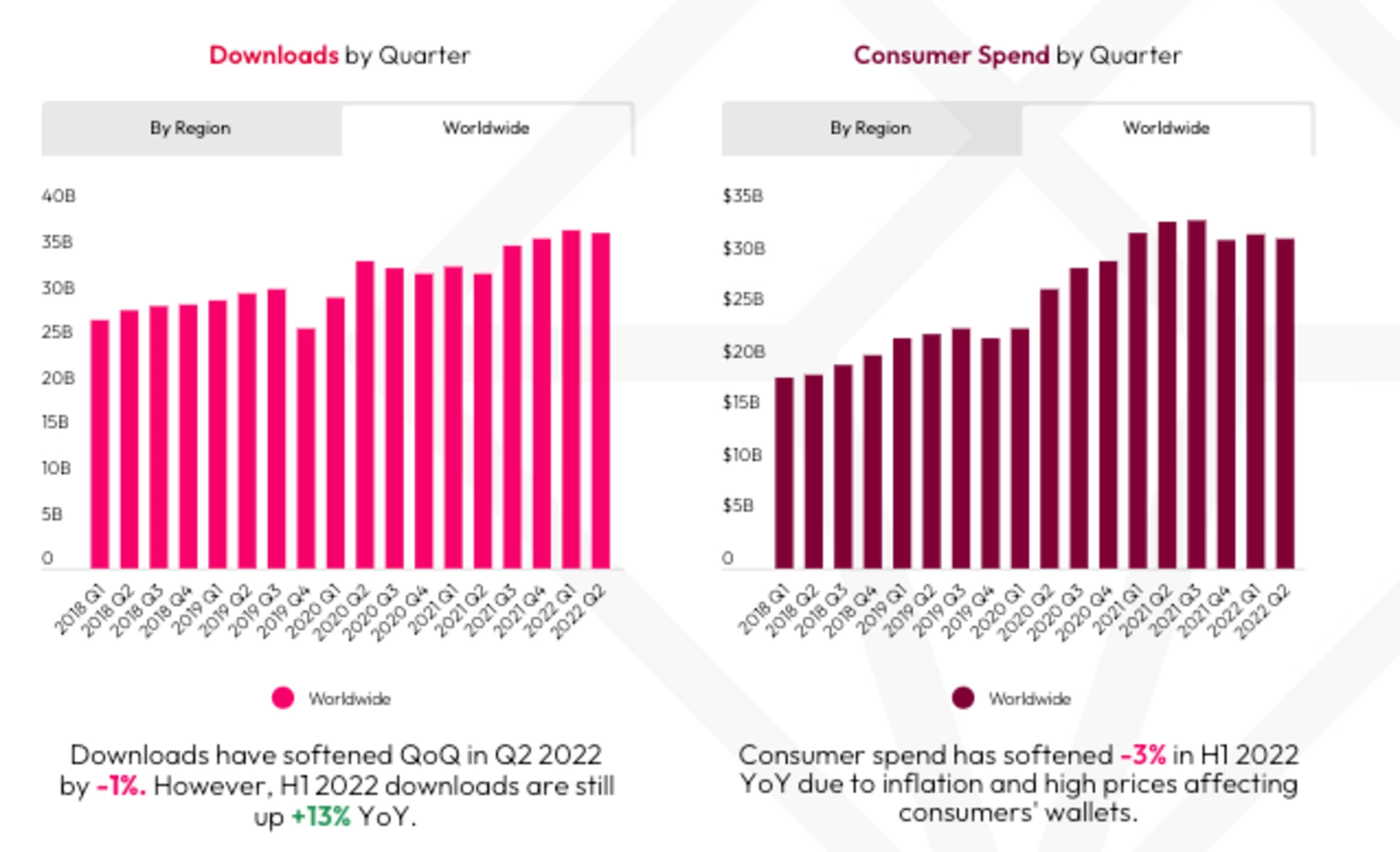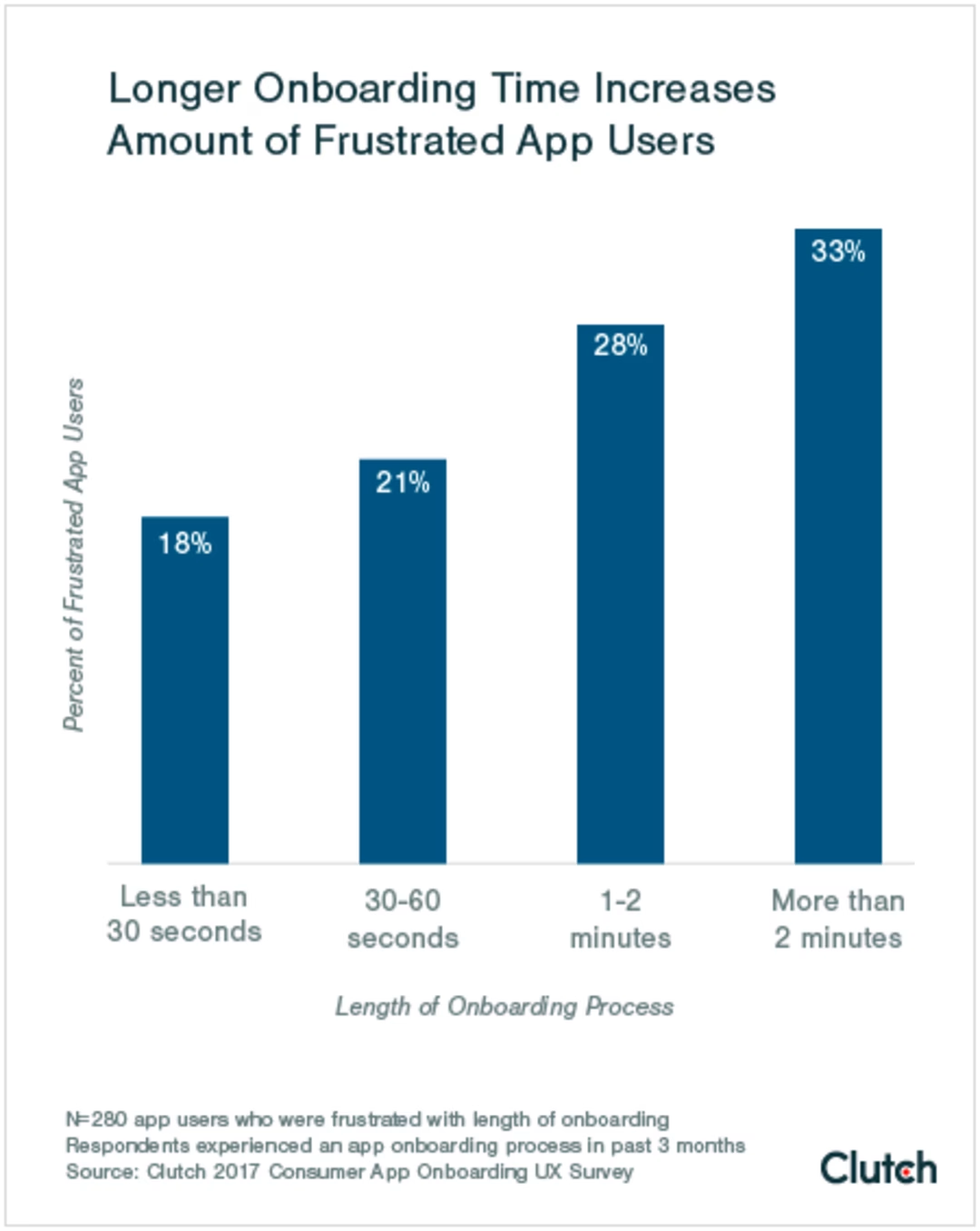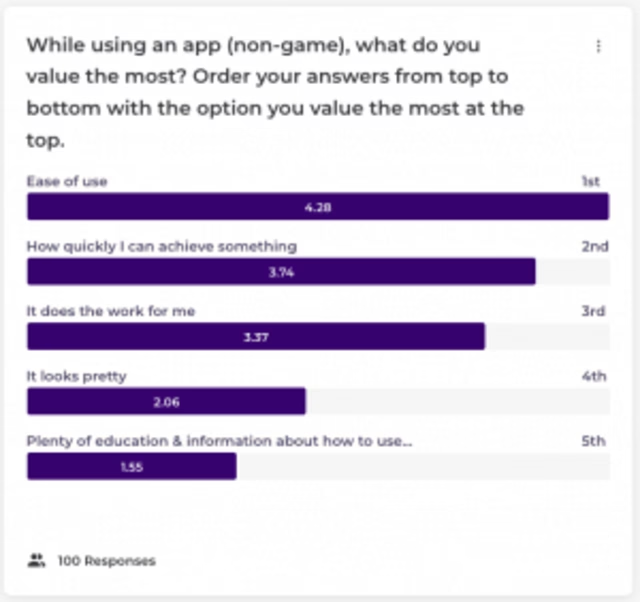Mobile apps are more critical today than they’ve ever been for user acquisition, customer retention, and your bottom line.
That’s because app users convert at a much higher rate than web users – as much as three times more, according to Criteo. According to Adjust, iOS apps retain around 13% of users on average after seven days.
App usage is robust too. Looking at data on app downloads and app revenue going back to 2018, we can see how resilient app performance was in the wake of the global Covid-19 lockdowns.

Image source: Data.ai, App Market Macro Results 2022
The charts above show a big drop in downloads in Q4 2019 – right around the start of the pandemic. Notice how it only took a couple of quarters for downloads to bounce back, while the consumer spend increased rapidly after that initial dip.
The significance of this trend is that the pandemic caused some of the biggest recessions in living memory all around the world. Although no one wants to go through such a horrible experience again, it did prove the resilience of the app market even in the face of sudden, record recessions. It’s reassuring to see that spending and downloads both rose quickly and have stayed relatively stable as we’ve emerged from Covid.
The pressure is on mobile app product owners to perform in terms of user acquisition
Despite the current economic uncertainty, most app product managers still have double-digit growth targets when it comes to acquisition, retention, and revenue. This is partly because mobile apps proved so reliant during Covid. It’s also because if consumer spending does continue to fall overall, companies will rely more on apps due to their high retention rates compared with other channels.
In that sense, mobile apps are the customer loyalty programs of the 21st century. I may not carry a supermarket loyalty card around in my wallet anymore, but you can bet I scan my supermarket app every time I shop for groceries in return for discounts and specials offers on my favorite foods.
So, we’ve seen why it’s so important to attract and retain mobile app users. They convert at a higher rate and they are good for customer retention. However, as consumer spending reduces, there’s going to be a lot more competition for those users. So let’s take a deeper dive into where mobile app product users and optimization specialists should focus their efforts when it comes to optimizing user acquisition and retention in the months ahead:
1. Offer the smoothest possible onboarding experience
We all know that app users are impatient. According to this research, a full third of users will experience frustration if an onboarding process takes more than 2 mins and 18% of them if it takes longer than 30 seconds.
Yet most apps are legally obligated to follow set rules for onboarding customers–especially in financial services, where very strict Know Your Customer rules can’t be skipped. So check out what your competitors are doing in your space and make sure that your onboarding process is one of the shortest in your category.

Image source: Clutch, Consumer App Onboarding UK Survey
2. Emphasize consumer trust to improve your mobile app user acquisition
Mobile app owners get a ton of questions from users these days about the use of their private data. Why does LinkedIn want to access my Bluetooth? Why does Bitmoji ask for my location? Why does this rideshare app want access to my camera?
Users don’t trust apps with their data – not anymore. You only have to look at the recent fines levied against TikTok to see that lack of trust over data use is very much a relevant concern.
There is a large section of users in most markets who prioritize their data privacy. That puts the emphasis back on app owners to communicate clearly what they use user data for, how well protected it is, what it will not be used for, and so on. This is a huge potential barrier to acquiring many users, so don’t neglect it.
3. Focus on ease of use for new users
This may seem like an obvious point but it’s worth emphasizing that customers rate this as more important than any other single factor.

Image source: 2020 Kantar survey
Note also that “How quickly I can achieve something” comes second in the above list of priorities for new users. This also doubles as a great tip since the sooner a new user can achieve something, the easier your app is to use.
So focus on steering new users towards an early achievement and make sure you gather plenty of user feedback around ease of use that you can apply as you continually iterate the UX in your app.
4. Focus on organic downloads rather than paid
Organic app downloads are more valuable than those you get through paid ads. For a start, the majority of app downloads are organic – in the Apple App store it’s 65%. On top of that, organic downloads have a 20% higher retention rate after 7 days than user who came from paid ads.
Not only are you more likely to get a user organically, but users that you get this way are more likely to stick around. If you don’t rank high in organic search within the app store (or the Google Play store), that’s going to have a huge impact on the number of downloads and opportunities you get to attract new users and optimize your mobile app user acquisition. The two factors you can focus on to improve your organic rankings are:
Downloads. The more downloads you get in your category, the better the chance that the app stores will push you into the top 100 rankings for that category. Being at the top of those rankings is fantastic news, and you get lots of additional organic downloads from users seeing your app who might not otherwise have been exposed to it.
Reviews. If you have lots of 4 and 5-star reviews in the app stores, you’re more likely to get featured by the app store and more likely to rank higher because users like your app and they actively go in and put reviews in there. This is another key reason to focus on UX and ease of use, since this will get you more positive reviews.
Tip #5: Be wary of your uninstall rate
There’s one key app metric that impacts your organic app store rankings that you can’t even measure: uninstall rate. Any time a user downloads your app, opens it, uses it for two minutes and then uninstalls, that uninstall gets fed back to the app stores who then use that metric to make sure they’re serving their users with apps they are less likely to uninstall.
If you are giving users a poor enough app experience that a significant number of them are uninstalling, you will get fewer downloads, even if you’ve had lots of users download your app. If enough users uninstall your app, you are going to go down in the search rankings.
One user with a bad experience could cost you two, three, or four other new users who potentially could have seen your app through those organic means. The uninstall rate is a force multiplier, in other words, and yet another reason why user experience is so critical – not just for retaining users on your app, but also for attracting new users who won’t even see your app unless it ranks high enough in the organic rankings.
If you only take one thing from this blog post…
Make sure you focus above all on having the best mobile UX out of all the apps in your category and amongst your competitors. UX is the factor with the biggest potential to impact your success—for better or worse. Not only will great UX improve your retention rates and lifetime customer value, but it will also have the single biggest impact on customer acquisition.
See how UX analytics could boost your mobile app performance
Find out how Contentsquare’s mobile analytics could help optimize your mobile app acquisition and retention by booking a demo with our experts.
![[Stock] Analyse mobile](http://images.ctfassets.net/gwbpo1m641r7/7gmMbrNsaNsDLbLXdY98Kz/7be0c2c52fe689c4508a97f8321c8560/analyse-mobile-guide-complet.png?w=3840&q=100&fit=fill&fm=avif)
![[Visual] Andy Pelly](http://images.ctfassets.net/gwbpo1m641r7/2SEoaBml14b68Z7v01lLj0/cd4bd601f762e3a68b9b3fccecf9f3d9/T027K0ZC9-U01TCLE3ML2-4f6515016808-192.jpeg?w=384&q=100&fit=fill&fm=avif)
![[Visual] Contentsquare's Content Team](http://images.ctfassets.net/gwbpo1m641r7/3IVEUbRzFIoC9mf5EJ2qHY/f25ccd2131dfd63f5c63b5b92cc4ba20/Copy_of_Copy_of_BLOG-icp-8117438.jpeg?w=1920&q=100&fit=fill&fm=avif)